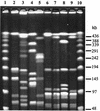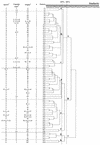Genetic diversity of Streptococcus suis strains isolated from pigs and humans as revealed by pulsed-field gel electrophoresis
- PMID: 11825980
- PMCID: PMC153394
- DOI: 10.1128/JCM.40.2.615-6192002
Genetic diversity of Streptococcus suis strains isolated from pigs and humans as revealed by pulsed-field gel electrophoresis
Abstract
The genetic diversity of 123 Streptococcus suis strains of capsular types 2, 1/2, 3, 7, and 9, isolated from pigs in France and from humans in different countries, was evaluated by pulsed-field gel electrophoresis (PFGE) of DNA restricted with SmaI. The method was highly discriminative (D = 0.98), results were reproducible, and the PFGE analysis was easy to interpret. Among all S. suis strains, 74 PFGE patterns were shown. At 60% homology, three groups (A, B, and C) were identified, and at 69% homology, eight subgroups (a to h) were observed. Strains isolated from diseased pigs or from humans were statistically clustered in group B, especially in subgroup d. By contrast, S. suis strains isolated from clinically healthy pigs were preferentially included in subgroup b of group A. Relationships could be established between capsular types 1/2, 3, and 9 and groups A, e, and B, respectively. S. suis strains isolated from humans were homogeneous, and a very high level of association between these strains and four DNA patterns was observed. The PFGE used in this study is a very useful tool for evaluating the genetic diversity of S. suis strains, and it would be used for epidemiological investigations.
Figures


References
-
- Allgaier, A., R. Goethe, H. J. Wisselink, H. E. Smith, and P. Valentin-Weigand. 2001. Relatedness of Streptococcus suis isolates of various serotypes and clinical backgrounds as evaluated by macrorestriction analysis and expression of potential virulence traits. J. Clin. Microbiol. 39:445-453. - PMC - PubMed
-
- Beaudouin, M., J. Harel, R. Higgins, M. Gottschalk, M. Frenette, and J. I. MacInnes. 1992. Molecular analysis of isolates of Streptococcus suis type 2 by restriction-endonuclease-digested DNA separated on SDS-PAGE and by hybridization with an rDNA probe. J. Gen. Microbiol. 138:2639-2645. - PubMed
-
- Berthelot-Hérault, F., H. Morvan, A. M. Kéribin, M. Gottschalk, and M. Kobisch. 2000. Production of muramidase released protein (MRP), extracellular factor (EF) and haemolysin by field isolates of Streptococcus suis capsular type 2, 1/2, 9,7 and 3 isolated from swine in France. Vet. Res. 31:473-479. - PubMed
Publication types
MeSH terms
Substances
LinkOut - more resources
Full Text Sources

